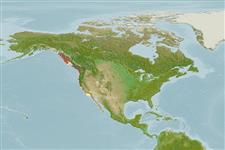>
Perciformes/Cottoidei (Sculpins) >
Cottidae (Sculpins)
Etymology: Artedius: Petrus (Peter) Artedi, (10 Mar.) 1705-35 (28 Sep.), a son of a clergyman from Anundsjö named Olaus Arctaedius, in the northern part of Sweden.In 1729 he changed his name from Arctaedius to Arctædi, a name still later simplified to Artedi (Ref. 45335); harringtoni: Named for Mark W. Harrington, President of the University of Washington (Ref. 6885).
Eponymy: Peter Artedi (1705–1735) was a Swedish ichthyologist, sometimes regarded as ‘the father of ichthyology”. [...] Mark Walrod Harrington (1848–1926) was an American botanist, astronomer and meteorologist who became President of the University of Washington. [...] (Ref. 128868), visit book page.
More on author: Starks.
Environment: milieu / climate zone / depth range / distribution range
Écologie
marin démersal; profondeur 1 - 21 m (Ref. 2850). Temperate; 58°N - 32°N, 155°W - 118°W
Eastern Pacific: Kodiak Island, Alaska to San Miguel Island, southern California, USA.
Taille / Poids / Âge
Maturity: Lm ? range ? - ? cm
Max length : 10.0 cm TL mâle / non sexé; (Ref. 2850)
Description synthétique
Clés d'identification | Morphologie | Morphométrie
Épines dorsales (Total) : 9 - 10; Rayons mous dorsaux (Total) : 16 - 18; Épines anales: 0; Rayons mous anaux: 10 - 14. Pelvic fins small.
Found in intertidal and subtidal rocky areas, around pilings (Ref. 2850). Males are territorial (Ref. 6885). Sexual dimorphism is remarkable (Ref. 74407). Males guard eggs (Ref. 74407).
Life cycle and mating behavior
Maturité | Reproduction | Frai | Œufs | Fécondité | Larves
Males guard clutches of eggs and are quite territorial (Ref. 74407). The following account of mating behaviour comes from Ragland et.al. (1978): observed from an aquarium, courtship began 'when a gravid female approached a shelter occupied by a male. The male, which was not guarding eggs, responded by rolling its head in a circle and flaring the orange branchiostegal membranes. The cirri were not moved or deployed in any obvious fashion.
The female either ignored the male or responded by snapping the head horizontally several times in rapid succession and occasionally quivering. Once she entered the nest, the male often extruded its pene and performed bouts of a fanning display similar to those of other cottids (Ref. 205). The female left the nest shortly after laying eggs.'
Occurrence of intromission was not observed from this study due to technical problems. However, eggs stripped from gravid females developed and hatched after 11-15 days in the absence of a male, thereby supporting the hypothesis that internal fertilization had occurred.
Eschmeyer, W.N., E.S. Herald and H. Hammann, 1983. A field guide to Pacific coast fishes of North America. Boston (MA, USA): Houghton Mifflin Company. xii+336 p. (Ref. 2850)
Statut dans la liste rouge de l'IUCN (Ref. 130435: Version 2024-2)
Menace pour l'homme
Harmless
Utilisations par l'homme
Pêcheries: commercial; Aquarium: Aquariums publics
Outils
Articles particuliers
Télécharger en XML
Sources Internet
Estimates based on models
Preferred temperature (Ref.
123201): 7.1 - 12.8, mean 10.1 °C (based on 178 cells).
Phylogenetic diversity index (Ref.
82804): PD
50 = 0.5312 [Uniqueness, from 0.5 = low to 2.0 = high].
Bayesian length-weight: a=0.00589 (0.00281 - 0.01234), b=3.15 (2.97 - 3.33), in cm total length, based on LWR estimates for this (Sub)family-body shape (Ref.
93245).
Niveau trophique (Ref.
69278): 3.4 ±0.52 se; based on food items.
Résilience (Ref.
120179): Milieu, temps minimum de doublement de population : 1,4 à 4,4 années (Preliminary K or Fecundity.).
Fishing Vulnerability (Ref.
59153): Low vulnerability (10 of 100).
Nutrients (Ref.
124155): Calcium = 142 [51, 339] mg/100g; Iron = 0.46 [0.21, 1.08] mg/100g; Protein = 17.3 [15.0, 19.5] %; Omega3 = 0.602 [0.229, 1.706] g/100g; Selenium = 7.75 [3.04, 20.40] μg/100g; VitaminA = 35.5 [9.1, 131.4] μg/100g; Zinc = 0.973 [0.600, 1.752] mg/100g (wet weight);
